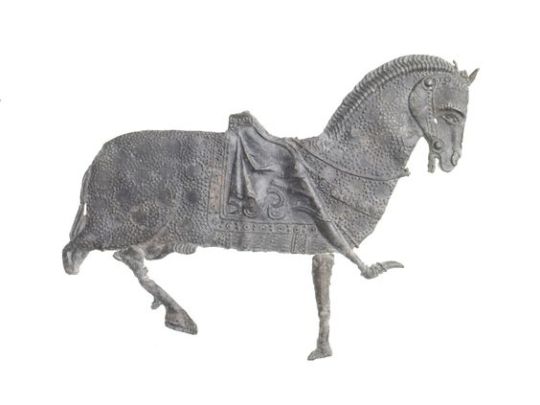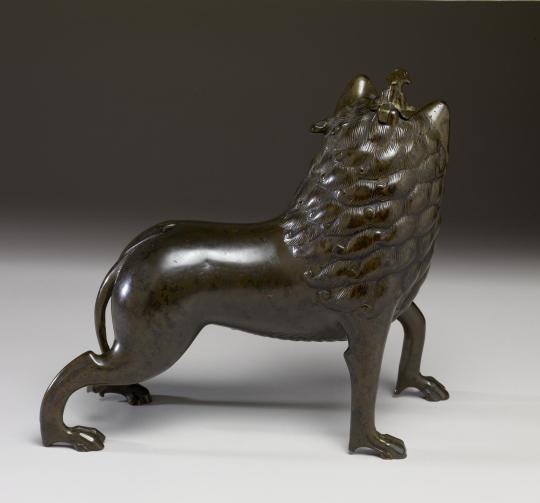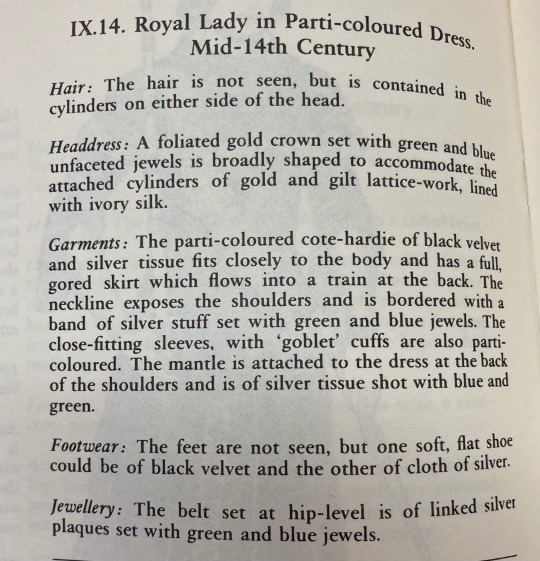#late 14th century
Explore tagged Tumblr posts
Text

Leather shoe, late 14th Century
From the London Museum
16 notes
·
View notes
Text

Part of a pilgrim badge from the shrine of St Thomas Becket at Canterbury Cathedral. This badge depicts part of the scene of Thomas Becket returning from exile in France and refers to his journey from Sandwich to Canterbury on horseback. All that remains of this badge is Becket’s dappled horse and the lower part of Becket’s body. Becket’s cloak hangs in folds across the saddle and his right leg is stretched out straight ahead. He wears pointed shoes.
Thomas Becket was born in London in 1118. He became a royal official and a great friend of King Henry II. He was made Archbishop of Canterbury in 1162. He argued with King Henry II, and fled to France in 1164. Thomas Becket returned to Canterbury in 1170 and was killed in the cathedral by four knights who thought this would please the king. People were outraged at the murder of an archbishop on holy ground and Becket was made a saint. He became one of the patron saints of London. Many Londoners travelled to Canterbury to pray at the shrine there and bought badges and ampullae (small bottles for holy water) as souvenirs of their pilgrimage.
Late Medieval; late 14th century
#St Thomas Becket#Late Medieval#late 14th century#pilgrim badge#patron saints of London#patron saint#museum of london
20 notes
·
View notes
Text
Wild how we know that Elizabeth Woodville was officially appointed to royal councils in her own right during her husband’s reign and fortified the Tower of London in preparation of a siege while 8-months pregnant and had forces gathering at Westminster “in the queen’s name” in 1483 – only for NONE of these things to be even included, let alone explored, in the vast majority of scholarship and historical novels involving her.
#lol I don't remember writing this - I found it when I was searching for something else in my drafts. But it's 100% true so I had to post it.#elizabeth woodville#my post#Imo this is mainly because Elizabeth's negative historiography has always involved both vilification and diminishment in equal measure.#and because her brand of vilification (femme fatale; intriguer) suggests more indirect/“feminine” than legitimate/forceful types of power#It's still bizarre though-you'd think these would be some of the most famous & defining aspects of Elizabeth's life. But apparently not#I guess she only matters when it comes to marrying Edward and Promoting Her Family and scheming against Richard#There is very lacking interest in her beyond those things even in her traditionally negative depictions#And most of her “reassessments” tend to do diminish her so badly she's rendered utterly irrelevant and almost pathetic by the end of it#Even when some of these things *are* mentioned they're never truly emphasized as they should be.#See: her formal appointment in royal councils. It was highly unconventional + entirely unprecedented for queens in the 14th & 15th century#You'd think this would be incredibly important and highlighted when analyzing late medieval queenship in England but apparently not#Historians are more willing to straight-up INVENT positions & roles for so many other late medieval queens/king's mothers that didn't exist#(not getting into this right now it's too long...)#But somehow acknowledging and discussing Elizabeth's ACTUAL formally appointed role is too much for them I guess#She's either subsumed into the general vilification of her family (never mind that they were known as 'the queen's kin' to actual#contemporaries; they were defined by HER not the other way around) or she's rendered utterly insignificant by historians. Often both.#But at the end of the day her individual role and identity often overlooked or downplayed in both scenarios#and ofc I've said this before but - there has literally never been a proper reassessment of Elizabeth's role in 1483-85 TILL DATE#despite the fact that it's such a sensational and well-known time period in medieval England#This isn't even a Wars of the Roses thing. Both Margaret of Anjou and Margaret Beaufort have had multiple different reassessments#of their roles and positions during their respective crises/upheavals by now;#There is simply a distinct lack of interest in reassessing Elizabeth in a similar way and I think this needs to be acknowledged.#Speaking of which - there's also a persistent habit of analyzing her through the context of Margaret of Anjou or Elizabeth of York#(either as a parallel or a foil) rather than as a historical figure in HER OWN RIGHT#that's also too long to get into I just wanted to point it out because I hate it and I think it's utterly senseless#I've so much to say about how all of this affects her portrayal in historical fiction as well but that's going into a whole other tangent#ofc there are other things but these in particular *really* frustrate me#just felt like ranting a bit in the tags because these are all things that I want to individually discuss someday with proper posts...
96 notes
·
View notes
Text




~ Aquamanile in the Form of a Lion.
Artist/Culture: German or Netherlandish
Date: late 13th or early 14th century
Period: Late Medieval
Medium: Brass
▪︎This unusual example bears a Hebrew inscription on one side that reads: (On the side and rear hip of the lion): ברוך אתה ה אלהינו מלך העולם אשר קדשנו במצוותיו וצוונו על נטילת ידים ; [Translation] Blessed be God, King of the Universe, who blessed us and instructed us to wash our hands (Baruch ata adonai alokhenu meleh Ha-olam asher Ridshanu bemitsvotsar vetsivanu al netilas yadayim).
#13th century#14th century#art#history#museum#medieval#late medieval#Aquamanile#lion#hebrew#German#Netherlandish#inscription
717 notes
·
View notes
Text

Niccolò di Pietro Gerini The Execution of the Four Crowned Martyrs
Tempera on panel, 40.2 x 44.5 cm, about 1385/90
#niccolò di pietro gerini#saint#four crowned martyrs#sancti quatuor coronati#martyr#14th century#gothic art#late gothic
25 notes
·
View notes
Text

Disney princess with a bit more accurate outfits...
.
.
.
#art#fanart#disney#princess#historical fashion#i know cinderella is supposed to be set in the 1860s#but the 1830s suit the story so much better#like she can still have her hair bun and bangs#and full dress#and her stepmother can have those long regency-esque dresses#and ruffles#and the stepsisters can have those crazy haistyles#i'm sorry i went on a rant#also my little mermaid is more inspired in the live action#because the og movie can go either 1830s os 1890s puffs#but the live action has a more late 1830s aesthetic#still i think they did the actress dirty in term of clothes and hair#especially hair color#so nothing really pops out#don't ask me why snow white is in the 1570s#i also don't know#Sleeping Beauty is supposedly set somewhere in the late 14th century#so i chose the 1380s because i like it
107 notes
·
View notes
Text





The Cathedral of St. Barbara - Kutna Hora, Czech Republic
Photos by Charles Reeza, October 2023
44 notes
·
View notes
Text

found some some farcilles in my doodle folder that I still kinda like so here you go 💖 lesbian aragorn and arwen you will always be famous
#dungeon meshi#farcille#this may be the most self-indulgent thing I’ve ever drawn haha#how are you friends!! it’s winter where I am#which makes looking at marcille in that purple dress a bit surreal actually. I keep feeling bad that I didn’t give her a jumper haha#designing outfits for these two has been SO FUN though#bc you guys know I’m a nerd for medieval fashion#and falin’s specific sensory issues mean I get to take more inspiration from the earlier parts of the period#which is less represented in fantasy couture compared to like the late 14th and 15th centuries and that is a CRIIIIIME#(I could segue into a full essay here about how glad I am for the autism representation in this series)#(but I have already been discussing that at length on my regular blog all year haha)#(so instead I will just say GO WATCH DUNGEON MESHI if you haven’t already! go watch it again if you have! it’s so so so good you guise)
17 notes
·
View notes
Text


- Margot Lister, Costume
43 notes
·
View notes
Text
Title: Standing Boy
Period: late Javanese period
Date: 12th–14th century(?)
Culture: Indonesia (Java)
Medium: Bronze
Dimensions: H. 4 7/16 in. (11.3 cm)
Classification: Sculpture
Credit Line: Samuel Eilenberg Collection, Gift of Samuel Eilenberg, 1987

#Title: Standing Boy#Period: late Javanese period#Date: 12th–14th century(?)#Culture: Indonesia (Java)#Medium: Bronze#Dimensions: H. 4 7/16 in. (11.3 cm)#Classification: Sculpture#Credit Line: Samuel Eilenberg Collection Gift of Samuel Eilenberg 1987#art#antique art japanesse#sculpture#indonesian art#art ghutry#xpuigc#xpuigc bloc
7 notes
·
View notes
Text
genuinely beleive all my problems would be solved if i owned a suit of armor. or at least a polearm
31 notes
·
View notes
Text
My biggest struggle as a gay man is wanting to queen out with Marguerite de Carrouges while knowing that she would call me a slur :(
#the last duel#jodie comer#ridley scott#ben affleck#matt damon#medieval history#medieval fiction#medieval europe#historical fiction#historical drama#middle ages#14th century#Late Middle Ages#Also she's dead#So#adam driver#Marguerite de Carrouges#Jean de Carrouges#jacques le gris
2 notes
·
View notes
Text
i think i've finally settled on a thesis topic ^_^ although it is very much complicated and frustrating and i need to talk to my professor
#i really want to include certain child ballads in it but unfortunately most of them were first written down in 15 - 18th century#which is beyond my proposed scope of study (late medieval england/14th century)#that being said these ballads were an oral tradition in the 14th century so maybe i can make the argument that they are still#medieval and not early modern???? idk. i need to talk to her ig#🍎
2 notes
·
View notes
Text
"Alice Perrers was perceived by her contemporaries to be an uncrowned queen and through an analysis of her activities it is clear she was able to utilise the practical benefits of queenship for her own ends. However, by taking on the mantle of queenship Alice fundamentally corrupted the sovereignty and kingship of Edward III. First, by her aggressively political behaviour she became the threat at the heart of the power structure that the gendered constructions of queenship were supposed to remove from a consort. Second, by taking on the practical aspects of queenship she inherently undermined the ideological role of queenship, both by the simple fact that she was a mistress and not a queen, and even more so because of her behaviour. The problems Alice caused and how she was perceived were amplified in contrast to the [...] demeanour of Philippa, who was widely respected and much loved by the people. Just as queens in their exalted position were ‘lightning rods’ for ideas about women and female power, so was Alice because of her proximity to the king."
— Laura Tompkins, The uncrowned queen: Alice Perrers, Edward III and political crisis in fourteenth-century England, 1360-1377 (Thesis, University of St Andrews, 2013)
"Alice's expansion of her power through the office of queenship was problematic for a number of reasons. First, while the queen’s power was legitimised by her marriage to the king and her coronation, Alice’s power was not formalised in this way and consequently would have been regarded as illegitimate. Second, she was not the right type of woman to share in the king’s dignity. She was not noble, she was not chaste and she was not virtuous. Instead, she was a low-born London widow and a businesswoman. Consequently, we find Alice being discussed in the language and stereotypes of queenship, but in a rather negative light. For example, while queens are routinely described as noble, beautiful and virtuous regardless of what they actually looked like, Walsingham is quick to emphasise that Alice was of low birth, and that, almost implied as a consequence, she ‘was not attractive or beautiful’. While we do not know what Alice looked like it seems unlikely that Edward III would have taken and kept her as a mistress for so long if she had been physically repellent. Third, and most significantly, not only was Alice an inappropriate mistress exercising illegitimate power, but she also broke all of the gendered rules that queenship was constructed around, inverting the ideal form of queenship to her advantage."
#alice perrers#historicwomendaily#14th century#english history#queenship tag#(sort of)#my post#This reminded me of something else I've been wanting to discuss#Namely: I really appreciate historians coming up with the 'quasi-queen' designation for historical women in late medieval England#(though imo there needs to be more of a discussion on actual contemporary perception of these women & if it aligned with the designation)#But I do think a side-effect of speaking of them collectively is that it tends to generalize their experiences in a way that#obscures their very different and very anomalous circumstances and tenures in power#Alice is arguably the one affected by it the most because of how fundamentally unique her situation was#Both in terms of her status (she was a commoner) and her position (as the king's mistress with an intrinsically extra-institutional power)#So I think the term 'unofficial queen' fits her actual role MUCH better#Not just because it fits her physical position by the king's side much better#But also because this was how she was explicitly recognized by contemporaries#(Poems had her 'replacing' the queen post 1369; she was called the king's 'wife'; etc)#queue#also im glad that tompkins pointed out the appearance thing because yeah lol
15 notes
·
View notes
Text

#juraj červenák#Kapitán Stein a notár Barbarič#joachimstein#Christ Pantocrator#blasphemous humour#but look at the glower#just look at it#could have sworn Stein stood model for the face#Košice#ťumblr#Kostol svätého Michala v Košiciach#late medieval#14th century#Central Europe
6 notes
·
View notes
Text

#ffxiv#final fantasy xiv#final fantasy 14#osmon#osmon no#this is how it starts osmon#it's not too much in the beginning#a drabble here#a first kiss fic there#then before you know it you're spending hours looking up 14th century armor and in-depth studies of wolves#to make your twenty-six chapter Medieval French ABO story as accurate as possible#walk away osmon#walk away before it's too late
2 notes
·
View notes